Scoring.
Everything you need to know about scoring
How to Score Baseball
That said, the fact is there is very little information you need to simply keep track of your offensive stats; if that is all you really intend to do with the score card. There is little need to know, when all is said and done, who hit who in, or moved a runner to what base, or where a base runner was eventually tagged or forced out.
It is important, however, to know who scored and who made out.
To do stats, we really only need to know one of two things about each at-bat:
- Did the batter get a hit or otherwise safely make it to first base?
- Did the batter make an out or cause another player to be put out?
- Did the batter cause another player, or himself, to score a run?
Here is how you do it!
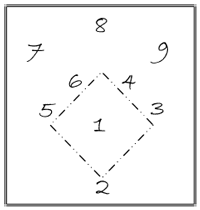 In short, I do not subscribe to any notion that one method is better than another. If one works for you, great, use it. It is simply a preference, and I prefer this one. It's quick, easy, and accurately keeps track of offensive stats, runs scored and outs made.
In short, I do not subscribe to any notion that one method is better than another. If one works for you, great, use it. It is simply a preference, and I prefer this one. It's quick, easy, and accurately keeps track of offensive stats, runs scored and outs made.
First lets go over the positions as they are referred to later. Each position on the field has a corresponding number from 1 to 9. The pitcher is 1 the catcher 2 and so on.
| Here are some basic scoring notations: | |||
 | Base Hit | 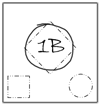 | Base Hit, Run Scored Later |
 | Base Hit, 1st Out Made Later |  | Home Run, 2 RBI, Run Scored |
 | Out, SS to 1st, 1st Out | 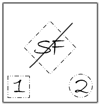 | Sacrifice Fly, 1 RBI, 2nd Out |
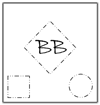 | Base on Balls | 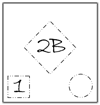 | Double, 1 RBI |
 | Fielders Choice |  | Grounded Into Double Play (GIDP), 2nd to SS to 1st, 2nd Out, No RBI |
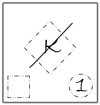 | Strike Out, 1st Out | 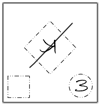 | Strike Out Looking, 3rd Out |
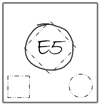 | Safe on Error by 3rd Baseman, Run Scored Later |  | Fly Out to Left Center, 2nd Out |
The previous examples are a sample of the various notations that can be used to score at-bats, runs scored and RBIs. If you have scored before using a traditional method, then many of the notations will no doubt look familiar. For example, a batter thrown out at first by the shortstop is shown as 6-3, and we place a 1,2 or 3 in the lower cirlce to designate which out it was. I will also put a slash mark though the whole diamond to designate that the batter is not on base and can therfore not score a run later. You will see why in a moment.
This is where my method differs from the more traditional methods. If the batter gets a base hit, instead of making the traditional mark along the lower right side of the diamond, we simply put 1B in the middle of the diamond. If this runner later scores, we simply circle the 1B. If he is later put out for any reason (e.g. forced out at 2nd, or tagged out at 3rd) we simply put a slash through the 1B and place a 1, 2 or 3 in the lower circle to designate which out it was.
The slash becomes an important part of the notation because it clearly defines batters/runners that are no longer on base and therefore have NOT scored and/or CANNOT score as opposed to those boxes that have either been circled (run scored,) or have neither a circle nor a slash which designates that the runner was left on base (LOB) at the end of the inning.
So here are the basic steps to scoring:
- Record the outcome of the batter's at-bat in the center of the diamond
- Circle any previous runners that came home to score as a result of the batters at-bat
- Record those runs as RBIs for the batter
- Slash out any runners/batter that were put out during the play
Here is a nice matrix of scoring notations and some final thoughts!
| 1B * | Base Hit | Batter safely reached first base. |
| 2B * | Double | Batter safely reached second base w/o an error. If a batter is thrown out at second trying to "leg-out" a double, the play should be scored a 1B and an out. |
| 3B * | Triple | Batter safely reached third base w/o an error. If a batter is thrown out at third trying to "leg-out" a triple, the play should be scored a 2B and an out. |
| HR * | Home Run | Batter safely reached home w/o an error. If the batter is thrown out at home trying to "leg-out" a home run, the play should be scored a 3B and an out. Always circle a HR and credit at least 1 RBI. |
| BB * | Base on Balls | A Base on Balls does NOT count as an At-Bat for the batter, and therefore does not affect the player's Batting Average. It does however favorably affect the player's On Base Percentage. |
| SF[n] * | Sacrifice Fly to fielder [n] | Score a Sacrifice Fly if a run scores as a direct result of the batter's caught fly ball. A run scoring on an error should not be scored a sacrifice fly. A Sacrifice Fly does NOT count as an at bat for the batter, and therefore does not affect the player's Batting Average. It does however adversely affect the player's On Base Percentage |
| SH[n-n] * | Sacrifice Hit (Bunt) | Score a Sacrifice Hit if any base-runner safely advances at least one base as a direct result of the batter bunting, and in the scorekeeper's opinion, the batter deliberately sacrificed his at-bat to advance the runner. This is one of the harder subjective rulings to make. Whether or not a run scored or even if the batter makes it safely to first by way of a fielder’s choice or error or even no action by the defense at all, should not change the score. The key question is whether or not the batter deliberately sacrificed his at-bat. A Sacrifice Hit does NOT count as an at bat for the batter, and therefore does not affect the player's Batting Average. It also does not affect the player's On Base Percentage. |
| FC | Fielder's Choice | This is probably the most confusing option of all. Score a fielder's choice if an out was made on a preceding runner as a direct result of the batter's at-bat. However, if all runners safely advance one base and the batter reaches 1st safely, then this becomes complicated. It is up to the scorekeeper to decide if an attempt (or choice) by a fielder to try and retire a preceding runner by force, gave up a guaranteed out of the batter at 1st. Just because a fielder makes a “bad choice” does not mean it is necessarily an error, although for this scoring method, it makes no difference since we aren’t keeping defensive stats. The question is, would the batter have been out, in the opinion of the scorekeeper, if the fielder had simply thrown to 1st? More on scorekeeping integrity below. |
| E[n] | Error on fielder [n] | Batter reached first base by an error. (e.g. E5 is an error on the third baseman.) A player reaching base by error can receive an RBI if there were less than 2 outs, and a run scored as a result of the batters's at bat, and in the score keepers opinion the run would have scored even if there was no error. |
| K | Strike Out | This is the traditional notation for a srike out. Make the K backword for a Strike Out looking. |
| F[n] | Fly Out to fielder [n] | Ball caught in the air by fielder [n]. |
| P[n] | Pop Out to fielder [n] | You can just as well use F[n] for this. Bottom-line, the ball was caught in the air. |
| L[n] | Line Out to fielder [n] | You can just as well use F[n] for this. Bottom-line, the ball was caught in the air. |
| [n]-[p] | Ground out | Fielded by fielder [n] and thrown to fielder [p]. Fielder [p] is most often 1st base (e.g. 5-3 3rd base to 1st base) |
| [n]-[q]-[p] | Multiple Touches | This is a common notation for a Douple Play (e.g. 6-4-3, SS to 2nd base to 1st base,) but it is used any time multiple players touch the ball on the way to an out. |
| GIDP | Grounded into double play | This is my method for denoting a double play. I simply put GIDP for the batter and cross out the other runner that was put out. |
| NH * | No Hit | To make life really easy, I will sometimes simply replace all notations above that don't have an * with NH to denote that the batter did not get a hit or otherwise reach first base safely. In the end, it really doesn't matter how the batter got out or even how they got to first if they did not get a hit, walk or sacrifice. |
Final Thoughts
A word on scoring integrity. This is not so much an issue of ethics as, in the end, nobody but you will know if your batting average is legit or not. If you are keeping stats, my advice is to be honest and show the tough love. If you score a FC or an E, then so be it: score a FC or an E and stick by your decision. Don't let the batter argue the point. If they don't like the method you are using, or your scoring decisions, tough! Sometimes it sucks to be the one to lower a player's batting average or slugging percentage, but integrity should rule here, and consensus usually comes out on your side anyway. In the end, it is a pain in the butt to keep a good score card, but most players will agree, it's nice to see their name and stats in lights (or on the Internet), even if they suck.
Happy Scoring,
david
